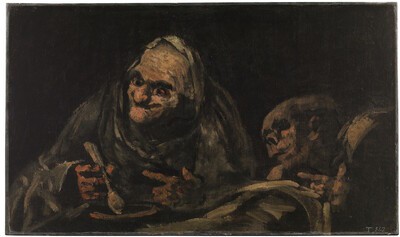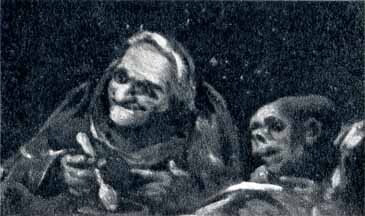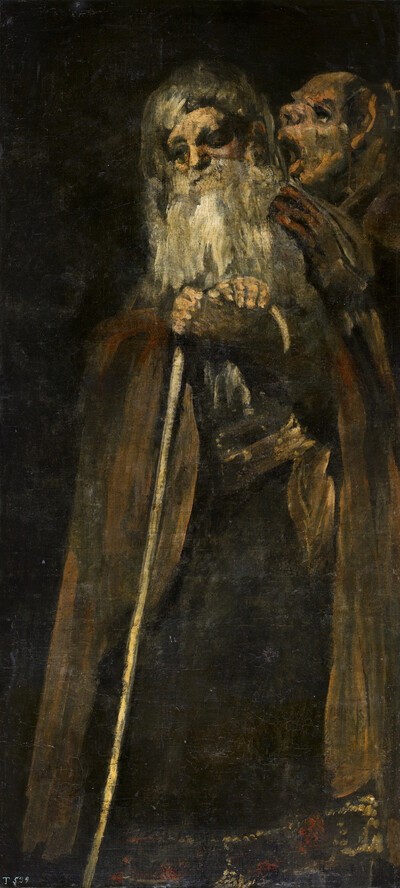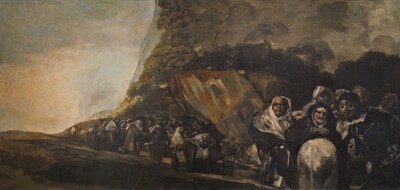- Cronología
- Ca. 1820 - 1823
- Ubicación
- The Prado National Museum. Madrid, Madrid, Spain
- Dimensiones
- 127 x 263 cm
- Técnica y soporte
- Oil painting on plaster transferred to canvas
- Reconocimiento de la autoría de Goya
- Undisputed work
- Titular
- El Prado National Museum
- Ficha: realización/revisión
- 01 Nov 2010 / 03 Oct 2023
- Inventario
- (P00756)
See Leocadia.
This work was situated on the first floor of the building on the right-hand wall next to the Procession of the Holy Office (Paseo del Santo Oficio).
It is the most mysterious of the paintings located in the house. X-rays have confirmed that the two main figures in the paintings are superimposed on the landscape in the background, which features figures in the distance and an imposing mountain that can be linked to another depicted by Goya in a previous work. It is one of the better lit scenes, with the darkest section in the foreground where two figures who seem to be soldiers aim their guns diagonally towards the large crowd of people in the centre of the composition. The most striking figures are the two who are flying through the air. One is pointing towards the mountain in the distance while the other covers her face with a red cloak which stands out against the background. Moffit identified the pair of floating figures as the goddess Minerva transporting Prometheus to Mount Caucasus. Brugada's title, which might have come from Goya or someone in his family, refers to the female name of the biblical demon from the Book of Tobit responsible for the death of all men who married Sarah until the last of them, Tobias, managed to render the evil spirit harmless with the help of the Archangel Raphael. Asmodeus as a flying demon served as inspiration for the work The Lame Devil (El diablo cojuelo) by Luis Vélez de Guevara in which this demon flies above the houses, snooping under people's roofs, and this story has also been suggested as providing a possible meaning for the painting. In any event, flying and travel are a common element of all the interpretations made of this work.
-
Pinturas Negras en la Exposición Universal de ParísPalacio del TrocaderoParís1878from may 20th to November 10th 1878
-
Goya. Das Zeitalter der Revolucionen. Kunst um 1800 (1980 – 1981)Hamburger KunsthalleHamburg1980cat. 298a
-
Goya. 250 AniversarioMuseo Nacional del PradoMadrid1996consultant editor Juan J. Luna. From March 29th to June 2nd 1996cat. 163
-
Vie et ouvre de Francisco de GoyaParísOffice du livre1970pp. 327-329, cat. 1620
-
BarcelonaPolígrafa1970vol. I, p., cat.715
-
Goya's Black Paintings: Truth and Reason in Light and LibertyNew YorkHispanic Society of America1984p 122-130
-
Goya. 250 AniversarioMadridMuseo del Prado1996p.430-431
-
Las pinturas negras de Goya, AlcobendasT.F. Editores1997p.72
-
Las Pinturas Negras de GoyaLondonScala Publishers Ltd.2003p. 91-92









